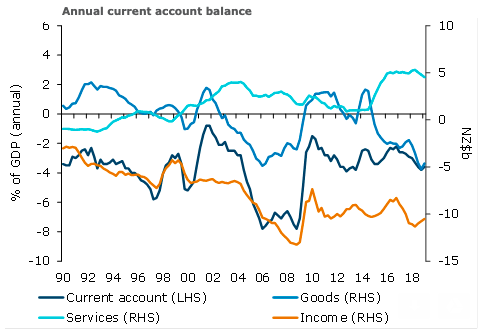New Zealand’s annual current account deficit narrowed $0.6 billion from an upwardly revised Q4 to $10.6 billion in Q1. This saw the current account deficit as a share of GDP narrow from 3.8 percent to 3.6 percent, which is in line with its historical average.
As is typically the case, the unadjusted quarterly current account transitioned from deficit in Q4 to surplus in Q1 (from -$3.5 billion to $0.7 billion). This was slightly larger than the $0.2 billion surplus we had pencilled in. Much of the variance seems timing related, with revisions appearing to capture a large chunk.
The goods deficit flipped into surplus, reflecting an unwinding in seasonal import demand over the summer months and as exports remained robust on the back of still-high prices and solid agricultural production in recent quarters.
While the OTI terms of trade suggest goods export prices did indeed fall in Q1, this was by less than the decline in import prices, with the net impact on the trade balance being positive.
The unadjusted services surplus widened from $1.0 billion in Q4 to $3.0 billion in Q1 as imports dipped (fewer kiwis go on overseas holidays when the weather back home is good) and exports lifted, reflecting the usual seasonal peak international tourism demand.
In seasonally adjusted terms, the current account deficit was broadly stable in Q1, narrowing by just $60 million. A smaller goods deficit (on slightly softer imports) was offset by a smaller services surplus, which shrank by around $0.1 billion on the back of higher services imports.
As expected, New Zealand’s net international liability position (NILP) improved (by $4.0 billion to $164.4 billion), largely reflecting a rebound in the value of offshore assets following Q4’s downward revaluation on the back of the global equity wobble late last year. As a share of GDP the NILP fell 1.9 percentage points to 55.5 percent.
Image courtesy: ANZ Research



 Kevin Hassett Says Inflation Is Below Target, Backs Trump’s Call for Rate Cuts
Kevin Hassett Says Inflation Is Below Target, Backs Trump’s Call for Rate Cuts  Precious Metals Rally as Silver and Platinum Outperform on Rate Cut Bets
Precious Metals Rally as Silver and Platinum Outperform on Rate Cut Bets  Silver Prices Hit Record High as Geopolitical Tensions Fuel Safe-Haven Demand
Silver Prices Hit Record High as Geopolitical Tensions Fuel Safe-Haven Demand  Asian Markets Rebound as Tech Rally Lifts Wall Street, Investors Brace for BOJ Rate Hike
Asian Markets Rebound as Tech Rally Lifts Wall Street, Investors Brace for BOJ Rate Hike  U.S. Stocks End Week Higher as Tech Rally Offsets Consumer Weakness
U.S. Stocks End Week Higher as Tech Rally Offsets Consumer Weakness  New Zealand Business Confidence Hits 30-Year High as Economic Outlook Improves
New Zealand Business Confidence Hits 30-Year High as Economic Outlook Improves 






























